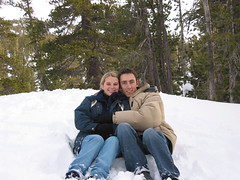On the loose in the Yucatán
We were off by 8:00 this morning in our cherry red Ford Ka rental car, headed south to visit several of the ruins sites around Mérida. First we had to stop at Penmex, the government monopoly that owns all of the country´s petrol stations. Then we missed the turnoff and had to do a few loopty loops around before getting on the right road. No dramas though. It took just over an hour to reach the ruins of Uxmal, driving along a 2-lane road surrounded by hilly jungles and not much else. Sadly, our little car didn´t have a radio so we couldn´t rock out to Mexican hits.
Uxmal was built around 600AD and was a pretty large and important city until around 900AD. Perhaps drought caused the inhabitants to move on. The first building we came to was the Casa del Adivino, the Magician´s House. It is a pyramid like temple 39 metres high and a bit different because it is oval in shape with rounded sides. There were not too many people there so it was pleasant walking around the jungle setting of the ruins and learning more about each building. Many of them are piles of rubble, some completely overgrown, but it´s still an interesting and pretty site.
Back on the road, it didn´t take too long to reach our next stop, the ruins of Kabah. It was the second most important city in the area after Uxmal, inhabited from 750AD to around 950AD. It´s a small complex, and we had the entire place to ourselves for the hour or so we were there. Most of the ruins have partially been swallowed up by the jungle, making us wonder how much of it is probably still under earth. The largest building is El Palacio de los Mascarones (Palace of the Masks), covered in over 300 carvings of Chac-Mool the Rain God. It was pretty impressive, and we could imagine how it would have looked when all of the Chac-Mool elephant-like noses were intact and protruding from the wall. Also at this site is a huge arch. Once a sacbé (cobbled, ceremonial pathway) led from this arch, through the jungle and all the way to Uxmal in one direction and Labná in the other. At one time all of the Yucatán Peninsula was connected by these white roads of limestone.
After Kabah was Labná, even more tangled up by the surrounding jungle. There is another arch here, probably part of the ceremonial road. But we like to think that they were Mayan telephones, and because of their perfect construction, sound was able to carry from one archway, through underground tunnels and all the way to other archways. We can have a bit of fun with these sites anyway.
By this time it was after 2:00. We drove to the small town of Oxkutzcab to get lunch. Unfortunately, the one restaurant we found open didn´t really have any food, so we ended up eating chips and dip from a small market. It was enough though because it was so hot we didn´t have too much of an appetite. Driving back to Mérida we had planned to stop at one or two cenotes. These are sinkholes formed when cracks in the earth fill up with rainwater and the surface layer of earth erodes, creating a system of underground rivers and cenotes. They are all over the Yucatán Peninsula. Some people believe that an asteroid or some other huge collision 65 million years ago struck the Yucatán (on the Gulf of Mexico coast just east of Progresso), forming these cracks and also wiping out the dinosaurs. Anyway, we didn´t have enough time for a swim in caves, so we headed back to the city.
It was still hot by the time we got to Mérida at about 5:00. We returned the rental car, used the internet and had some dinner. We played some cards at the hostel and listened to the guitar señor´s music for a bit, but were too exhuasted to stay up and went to bed.


2 Comments:
This comment has been removed by a blog administrator.
This comment has been removed by a blog administrator.
Post a Comment
<< Home